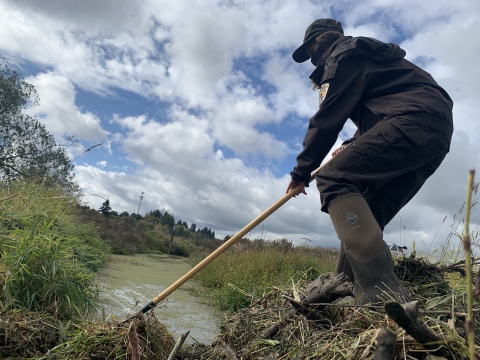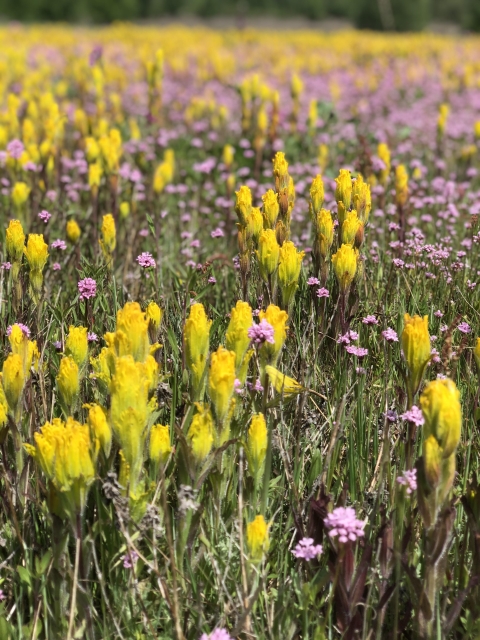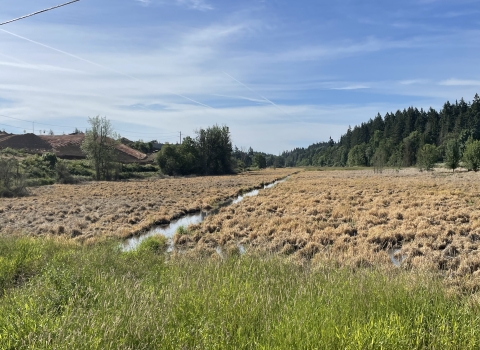What We Do
The National Wildlife Refuge System is a network of public lands and waters managed by the U.S. Fish and Wildlife Service. Wildlife conservation is at the heart of the National Wildlife Refuge System, and drives everything we do, from the initial establishment of a refuge, to the recreational activities offered here. Utilizing the right management tools helps us to further the conservation and restoration of wildlife and their habitats.
Management and Conservation
Refuges use a wide range of land management practices in order to work towards restoration and management goals. These practices range from active approaches such as prescribed burns and invasive plant removal, to more passive techniques. The methods and tools that are used are aimed to ensure a balanced conservation approach where both wildlife and people will benefit. Our full Comprehensive Conservation Management Plan is available here.
Stop-over for Migratory Flyways
Among the four designated flyway routes in North America, Tualatin River NWR is along the route of the Pacific Flyway route; this migratory route is utilized by billions of birds every year, and spans from Alaska through South America. Tualatin River NWR provides important habitat for migratory birds seeking refuge and respite along their migratory route. Management actions to provide habitat and food for migratory birds include restoration for emergent wetland, mixed coniferous/deciduous forest, and riparian riparian
Definition of riparian habitat or riparian areas.
Learn more about riparian forest habitat, and closing of our seasonal trail to provide sanctuary for wintering waterfowl.
Cooperative Farming
Cooperative agriculture may take place on certain units of the refuge, in order to benefit migrating and wintering waterfowl and shorebirds. In the event of a call for cooperative farming, applications would only be open on a seasonal and occasional basis, so please check back to the website for cooperative farming opportunities.
Prescribed Fire
This management tool helps to clear sites of invasive plants as well as their seed banks before planting native species. Historically, the Kalapuyan peoples utilized fire and prescribed burning to maintain oak savanna habitat; this technique has been previously used at some of our oak savanna habitat sites, to eliminate competition from invasive species invasive species
An invasive species is any plant or animal that has spread or been introduced into a new area where they are, or could, cause harm to the environment, economy, or human, animal, or plant health. Their unwelcome presence can destroy ecosystems and cost millions of dollars.
Learn more about invasive species such as blackberry, in order to promote growth of other native plant prairie species, endemic to the Willamette Valley.
Habitat Restoration
With numerous habitat types within the boundaries of the Tualatin River NWR, there is no short-supply of refuge habitat restoration projects. The work includes smaller endeavors such as invasive plant control at some sites, to our large multi-year projects, such as our Chicken Creek restoration project.
The refuge supports the protection and recovery of federally listed, state-listed, and other special-status species, which has included undertaking projects to support and supplement regional recovery plans for many at-risk plant species in efforts to restore native prairie and oak savanna habitat, including Nelson’s checkermallow and golden paintbrush.
Restoration and maintenance of in-stream and off-channel and other habitat types may benefit various native fish species including upper Willamette River Chinook salmon, Oregon chub, Pacific lamprey, coastal cutthroat trout, and upper Willamette River steelhead. In addition, most habitat types encountered on refuge lands could support some or all life phases of any number of listed species such as the bald eagle, northern red-legged frog, northwestern pond turtle, and others. When planning and implementing various restoration projects, consideration will be given to strategies that promote healthy populations of these species.
Inventory and Monitoring
The Fish and Wildlife Service is charged to “monitor the status and trends of fish, wildlife, plants, in each refuge.” Our inventory and monitoring plan includes different types of survey work, all utilized to monitor the status and any changes to these species at our refuge. Currently, refuge staff conduct spring surveys for migratory songbirds, winter surveys for migratory waterfowl and amphibian egg masses, and various plant surveys during the summer, among other monitoring projects.
Our Projects and Research
Our restoration projects help to further our purpose for the conservation, management and restoration of the fish, wildlife, plants and their habitats for the benefit of present and future generations of Americans. Our most recent project, the Chicken Creek restoration, is an exciting endeavor, and will benefit a variety of wildlife with over 280 acres of restored habitat, and will be a fantastic opportunity for visitors to see the real-time progression of a large-scale restoration project.
The refuge’s Rock Creek unit, located along Rock Creek and near Tonquin Road, is an important parcel as part of the larger Rock Creek Floodplain and surrounding forested areas. For the next 3-5 years, the site will undergo active restoration to return to a scrub-shrub wetland; a community of woody shrubs and emergent wetland plants that will be beneficial to a variety of...
Laws and Regulations
In order to provide and maintain our wildlife refuge as a home for a variety of wildlife, we ask that you follow our rules and guidelines while visiting and walking our trails.



